#Gale Gordon
Text

Lucille Ball; Desi Arnaz, Jr., Lucie Arnaz, and Gale Gordon for “Here’s Lucy” (1968-1974)
41 notes
·
View notes
Photo

“Lorrrr-eeeee!” - Gale Gordon
52 notes
·
View notes
Text
Also, shout out to Darla the Dog, who played the creepy poodle in Batman Returns.

She managed to be in a heck load of famous movies in the eighties and nineties, including…

Precious in The Silence of the Lambs…

Queenie in The ‘Burbs…
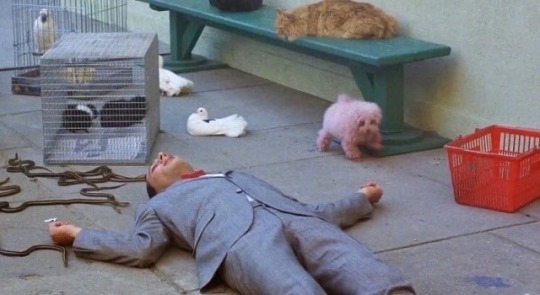
And a pink poodle in Pee Wee’s Big Adventure.
(I know what you’re thinking—these can’t all be the same dog. Indeed, Darla was the Robert De Niro of dogs.)
And apparently she lived to be the ripe old age of 17! So good for her!
#Batman Returns#Darla#Darla the Dog#The ‘Burbs#Gale Gordon#Pee Wee’s Big Adventure#Pee Wee Herman#Paul Reubens
39 notes
·
View notes
Text



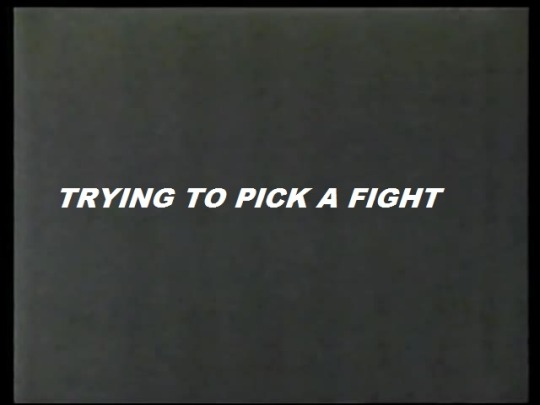

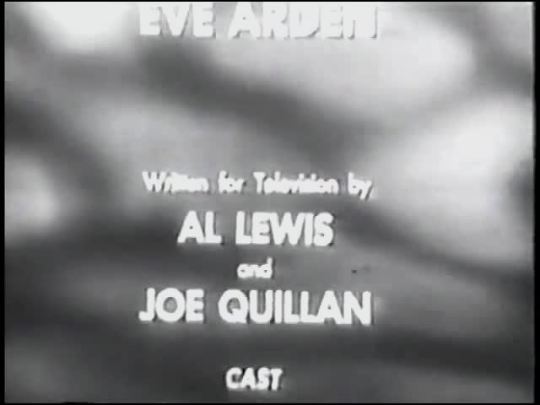
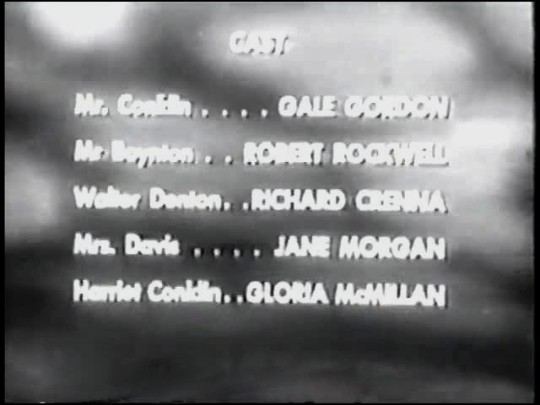






From the Golden Age of Television
Series Premiere
Our Miss Brooks - Trying to Pick a Fight - CBS - October 3, 1952
Sitcom
Running Time: 30 minutes
Directed by Al Lewis
Stars:
Eve Arden as Connie Brooks
Richard Crenna as Walter Denton
Gale Gordon as Osgood Conklin
Robert Rockwell as Philip Boynton
Jane Morgan as Mrs. Margaret Davis
Gloria McMillan as Harriet Conklin
Paula Winslowe as Martha Conklin (uncredited)
#Our Miss Brooks#TV#Premiere Episode#1952#CBS#Trying to Pick a Fight#Sitcom#Eve Arden#Richard Crenna#Gale Gordon#Robert Rockwell#Jane Moran#Gloria McMillan
2 notes
·
View notes
Text
LINE!!!
Lucille Ball: Scripts, Cue Cards, and Teleprompters

As a film star, Lucille Ball only had to memorize dialogue in short, bite-sized chunks. On radio, Lucille and her cast-mates read from scripts. But on television, in a realistic situation comedy, Ball needed to memorize a full thirty minute script a week!
CUE CARDS & PROMPTERS & SCRIPT SLIPS!
Credit for developing the cue card (sometimes derisively called ‘idiot cards’) is genereally given to John Barrymore, who had them tucked in out-of-the-way places during his stage performances in the 1930s.

Ed Wynn placed cue cards in the orchestra pit when he worked in vaudeville, then brought the practice to television with “The Ed Wynn Show” (1949-50), on which Lucille Ball got her first taste of the new medium, and was introduced to the concept of cue cards.

Wynn’s cards were prepared by Barney McNulty (1923-2000), known as the ‘King of Cue Cards’. He went on to form a company named Ad-Libs, a cue card company whose clients included many early TV stars, including Lucille Ball. McNulty later praised Ball for her cue card savvy:
“Hardly anyone realizes that the madcap redhead has cue cards on the set!”
McNulty claimed to have flipped cards for the “I Love Lucy” pilot episode. But “I Love Lucy” was quite different from shows starring Milton Berle, Ed Wynn, and Bob Hope, who did not use the convention of the fourth wall. Ball and her cast were performing a realistic teleplay that required them to make eye contact with their fellow actors, not look to cue cards. For this reason, cue cards were virtually unknown during “I Love Lucy.” Of course, there were exceptions...
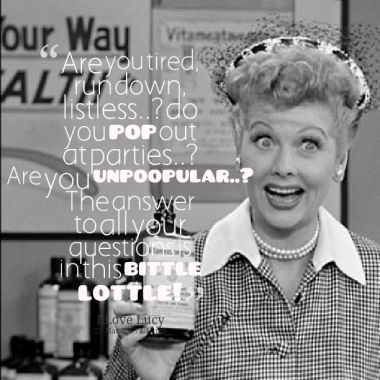
For her Vitameatavegamin spiel in “Lucy Does A TV Commercial” (1952) every slurred word and syllable was written in the script. To be letter perfect, and just to be on the safe side, Ball had cue cards set up in case she forgot her lines. Performing physical comedy in front of a live audience gets less laughs after the first take. Plus, re-takes were time consuming and expensive. It was hardly necessary. Lucy didn’t miss a beat and nailed it in one take.

On December 14, 1953, Lucille Ball and Desi Arnaz were the first to use a new teleprompting system developed by their producer, Jess Oppenheimer, although it was not the first in-camera system. Fred Barton had developed one as early as early as 1948. A forerunner to the modern video teleprompter, Oppenheimer’s “through the roll system” was later granted a US patent.

Lucy and Desi did not use it for the main show, which that night was “Lucy Has Her Eyes Examined”. Oppenheimer did not like that it obstructed the view of the live audience, but it was used for the Philip Morris commercials, which were filmed without an audience. The sponsors wanted their message clearly communicated, so it was important that the script be delivered verbatim. With the memorization of a weekly script, Lucy and Desi did not need the burdon of also memorizing commercial copy.
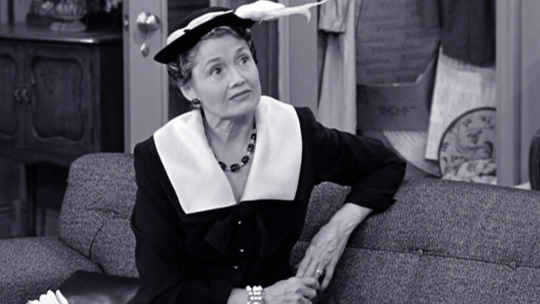
In “Lucy’s Mother-in-Law” (1954) the Ricardo closet door is wide open and it looks like there is a cardboard box of used cue cards stored in there! Even if they weren’t used on “I Love Lucy,” they might have been scared up from the Desilu prop room to “dress” the closet.

Bob Hope was notorious for his regular use of cue cards. When he guest-starred as himself on “I Love Lucy” in 1956, he read his lines from cue cards. It was prop man Jerry Miggins who was in charge of holding them for Hope.
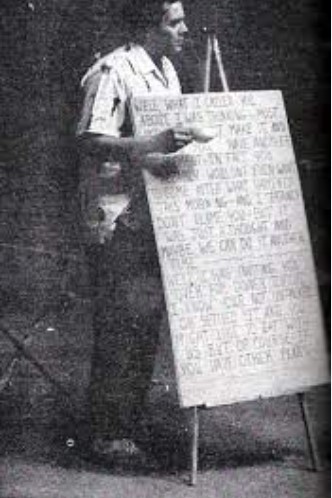
When “I Love Lucy” morphed into its hour-long format, cue cards were sometimes used, especially when the tensions of a failing marriage and running Desilu took Lucy and Desi’s time away from script memorization and busy guest stars did not have the time for extensive rehearsals. The above photo was taken during rehearsals for “The Star Next Door” (1957).
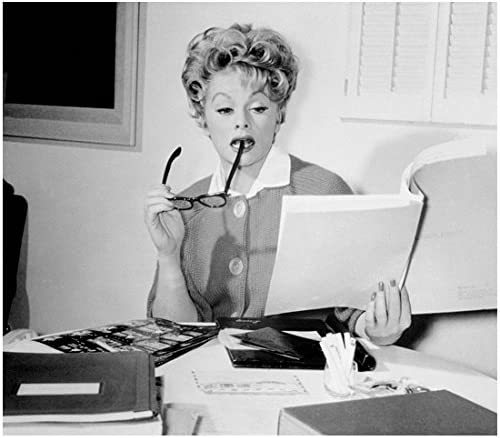
When Lucy launched “The Lucy Show” in 1962, she was also trying to run Desilu. Along with her adminsitrative duties, she still had to find time to learn a 30-minute script every week. She was also a newleywed and mother of two children, so time was precious.

Tony Mendez, who famously flipped cards for David Letterman and often appeared on camera as well, was interviewed by New York Magazine in 2001 and recalled how he got started in the business:

It seems that Lucille Ball was not the only one relying on cue cards. According to Mendez, Lucy merely needed a prompt, but Vivian needed the entire line!

In fact, the DVD extras for “The Lucy Show: Season One” include footage of Vivian using cue dards to do the show’s in-character commercials. They are positioned just behind Ralph Hart’s head!
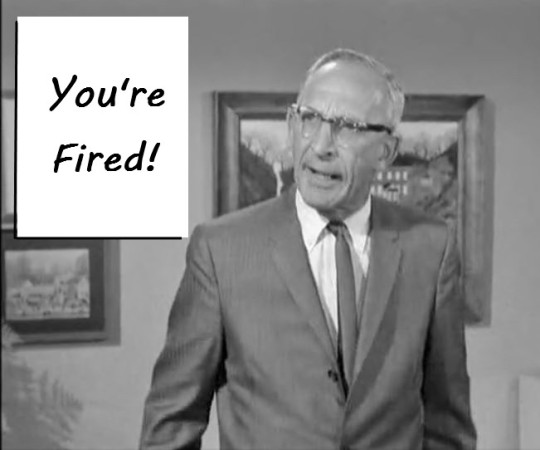
Lucy was was still adamant that her cast try and memorize their lines. When Charles Lane (banker Barndsdahl) stumbled over his dialogue, impatient Lucy used this as a reason to replace him. In reality, this may have been just the “for publication” story of what was actually Ball’s long-held desire to cast Gale Gordon. When the series began, Gordon was under contract to “Dennis the Menace” and couldn’t commit to Lucy. As soon as he became available, however, Lucy was not about to het him get away again - even if it meant dismissing Lane.
By “Here’s Lucy” - Ball’s third TV sitcom - she was using cue cards more often than not - espeically if the episode demanded a lot of rehearsal of music and dance.
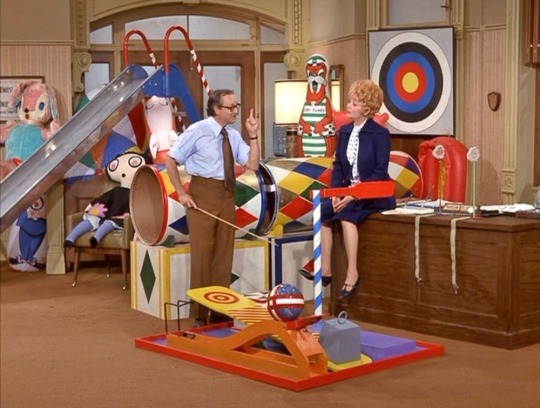
Tommy Tucker was the name of the “Here’s Lucy” cue card coordinator. Tucker and Lucy enjoyed playing word games together during lulls in shooting. As a tribute to him, the toy vendor played by Wally Cox in “Lucy Sublets the Office” (1972) was named Tommy Tucker. Tucker was interviewed for the short film “Lucy Meets The Burtons: A Comic Gem” which is included on the “Here’s Lucy: Season 3″ DVD.
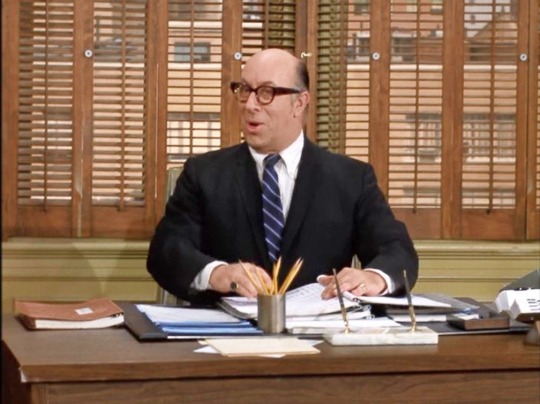
Coincidentally, one of the guest actors in this episode was Richard Deacon. His eyes can frequently be seen looking at the cue cards.

Another guest actor who’s eyes were usually seraching for the cue cards is Lyle Talbot, who played Harry’s lawyer in “Lucy Takes Over” (1970).

Not being an actor, Lawrence Welk’s eyes often distractingly glance over at the cue cards for his lines during his appearance on “Here’s Lucy” (1970). He smiles at his own jokes, and anticipates rather than reacts.

The webiste ‘Everything Lucy’ points to “The Bow-Wow Boutique” (1973) as when Lucille Ball started to rely almost exclusively on cue cards. Ball said that one of the hardest things to do was to erase the previous week's script from her mind to make way for a new one. After all, she was walking around the same set every week, having dialogue with the same people.

Filming a promotional spot with Bobe Hope, Ball squints at distant cue cards and quips,
“Well, let’s use the bigger ones. I can see the little ones, but why the hell not use the bigger ones?”
CHEAT SHEETS, SCRIPTS & CUES

Sometimes, a script - or a few pages of script - made it onto the set. A close-up of the Swiss cheese sandwich in “First Stop” (1955) shows a couple of pages of script on the table. A few lines have even been crossed out!

In “Lucy in the Music World” (1965) the verbose but funny album names were taped to the back of the record sleeves!
“He Wears a Hubcap for a Halo” (about a teenage girl whose boyfriend got run over by a police car)
“I've Got Tears in My Ears from Lying on My Back in My Bed While I'm Crying Over You”
“I Lost You to the Arms of Another” (about a girl whose boyfriend goes skin diving and gets tangled up with an octopus
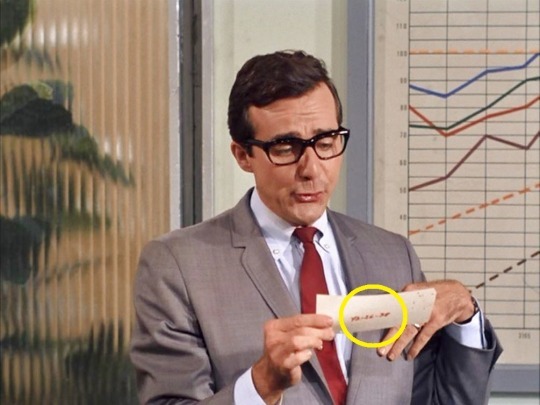
In “Lucy, the Matchmaker” (1968) Mr. Morton (Dick Patterson) reads Harry’s computer dating punch card. His match’s number is written on the card in red marker and the ink has bled through to the other side! Perhaps Patterson had trouble memorizing the number correctly?
PROTESTING CUE CARDS

Sometimes the materials that were used to create the cue cards were also used for other purposes. They were the perfect size for protest signs when “Lucy Goes on Strike” (1968).
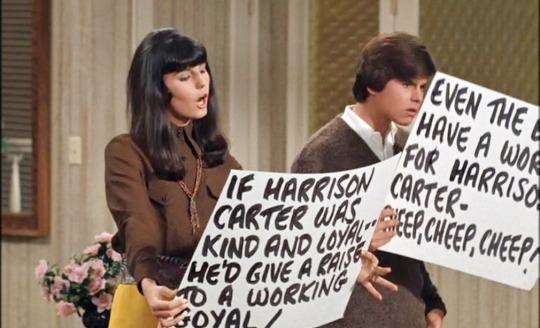
The distinctive all caps handwriting in bold black ink was a hallmark of cue card writers.

At the end of season five of “Here’s Lucy” in 1973, Ball had decided to end the series. She filmed an ending to the final episode where she hangs an “Out of Business” sign on the door of the Unique Employment Agency. But at the last moment, CBS convinced her to do a sixth season, so the ending moment was re-filmed with Lucy tacking a sign reading “Temporarily” above the “Out of Business” sign. The addional sign was obviously made from the same cardboard used for the cue cards - and by the same hand.

By the season six finale of “Here’s Lucy,” “Lucy Fights The System” in 1974, it was obvious that Ball was nearly completely dependent on the cue cards. Luckily, the storyline was basically carried by Lucie Arnaz, and Lucy’s scenes were mainly sitting at her desk.

During her final series, “Life With Lucy” (1986), it was well known that Lucille Ball read her lines from cue cards. She was 75 years old and in failing health, so it is an understandable accommodation.
#cue cards#teleprompter#I Love Lucy#Jess Oppenheimer#The Lucy Show#Here's Lucy#Lucille Ball#Gale Gordon#Lucie Arnaz#Desi Arnaz Jr.#Dick Patterson#Mel Torme#Mary Wickes#Lyle Talbot#Richard Deacon#Bob Hope#Wally Cox#Tommy Tucker#Charles Lane#Mary Emerson#Ed Wynn#Barney McNulty
11 notes
·
View notes
Text
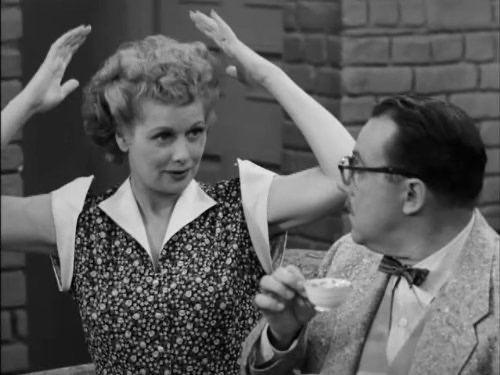
What do you mean, no stunts?? Our new episode, "Ricky Asks for a Raise," drops tonight at midnight!
8 notes
·
View notes
Photo

1974 television
4 notes
·
View notes
Text
Podcast Actor Gale Gordon Golden Age of Radio Tribute
0 notes
Text
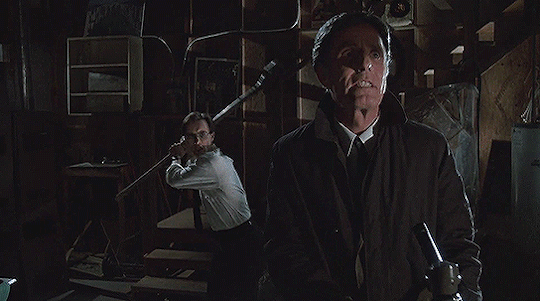


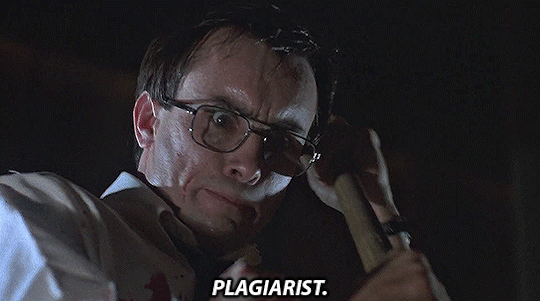

Re-Animator (1985) // Dir. Stuart Gordon
#Re-Animator#ReAnimator#Stuart Gordon#Jeffrey Combs#Herbert West#Carl Hill#Dr. Hill#Dr. Carl Hill#David Gale#B Movies#B Movie#Low Budget Movies#Horror#B Horror#B Movie Gifs#AVB#AVBGifs#AVRe-Animator#AVRe-AnimatorGifs#AVBHorror
2K notes
·
View notes
Text
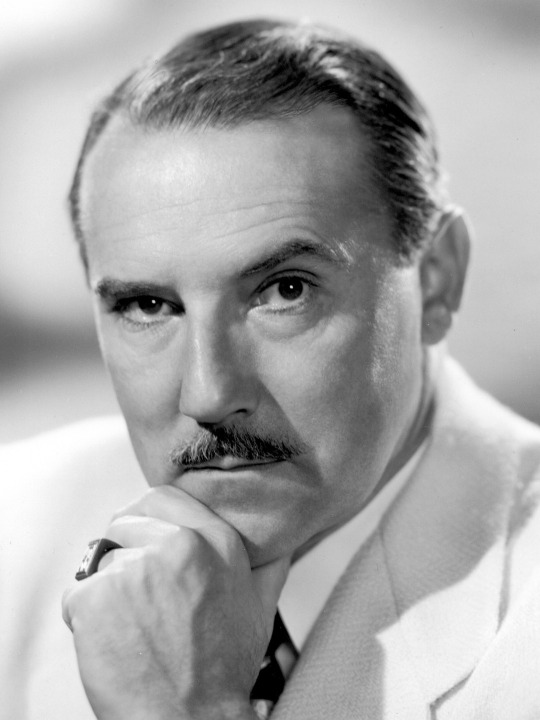
Remembering Gale Gordon on his birthday #botd
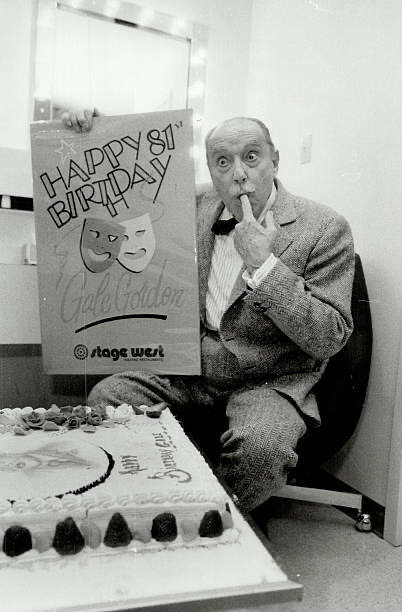
22 notes
·
View notes
Video
youtube
The Lucy Show | S05 E05 | Lucy and the Ring a Ding Ring | CC
Season 05, Episode 05 | 1966 | Closed Captioned. Lucy tries on an expensive ring Mr Mooney had made for his wife, it looks like the bank manager won't be able to give his spouse the anniversary present - it gets stuck on Lucy's finger.
#youtube#Lucille Ball#the lucy show#classic tv#classic television#videos#PAB network#classics#comedy#classic comedy#ring#gale Gordon#humor#tv#television#PABTV#PAB#PABdesk
1 note
·
View note
Text
Lucy's Halloween Nightmare
Lucy’s Halloween Nightmare
In this cartoonish fantasy sequence from Here’s Lucy, Lucille Ball and sidekick Vivian Vance are trapped in a haunted castle by her boss Mr. Mooney (Gale Gordon) who is actually quite believable as a scary vampire. Along the way they are accosted by a malevolent Morris chair, a gorilla, a lab assistant who is a mummy for some reason (probably because that’s what costume was available), a werewolf…
youtube
View On WordPress
1 note
·
View note
Text

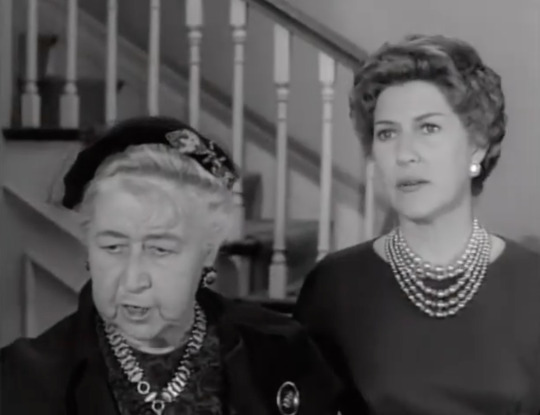


Verna Felton's total contempt for Gale Gordon
11 notes
·
View notes
Photo

just thought y’all should know that the tagline for the re-animator article in fangoria is “a mOiSt zombie movie”
#important info#do with this what you will#re-animator#herbert west#jeffrey combs#dan cain#bruce abbott#reanimator#david gale#fangoria#fangoria magazine#barbara crampton#re animator#stuart gordon
4K notes
·
View notes
Photo

TV Guide - August 4 - 10, 1962
Gale Gordon (1906 - 1995) Radio and television character actor best known for portraying Principal Osgood Conklin on “Our Miss Brooks”, banker Theodore Mooney on “The Lucy Show“ and John Wilson on “Dennis the Menace”. He also co-starred with Lucille Ball in the series “Here’s Lucy” and “The Lucy Show” as well as regularly guest starring in several sitcoms during the 1950′s.
Jay Waverly North (born August 3, 1951) Film and television actor. Beginning a career as a child actor at the age of six, he became a household name during the early 1960s for his role as the well-meaning but mischievous Dennis Mitchell on the CBS situation comedy Dennis the Menace, based on the comic strip created by Hank Ketcham.
As a teen, North starred in the NBC television series Maya. As an adult, he turned to voice acting work for animated television series, voicing the roles of Prince Turhan in the Arabian Knights segment of The Banana Splits Adventure Hour and a teenaged Bamm-Bamm Rubble on The Pebbles and Bamm-Bamm Show.
North’s first professional acting job was a live appearance on the gameshow Queen for a Day, hosted by Jack Bailey. He continued to work as a child model and actor in commercials, and landed small parts on a number of popular NBC variety shows of the 1950s, such as The George Gobel Show, The Eddie Fisher Show, and The Milton Berle Show, before auditioning for the role that made him a star.
46 notes
·
View notes
Text
TV on TV!
Part 3 ~ The Television Shows of the Lucyverse

Although it may seem redundant, the worlds created by Lucille Ball on television frequently created and mentioned other TV shows as well as popular TV commercials! Here are a few from “Here’s Lucy” (1968-1974), and one from “Life With Lucy” (1986).

“Lucy Visits Jack Benny” (1968)
At the end of the episode, bus driver Ralph Kramden (Jackie Gleason) makes an appearance at Benny’s barbecue. Gleason played the iconic character on his own variety show as well as the sitcom “The Honeymooners” (1955-56).
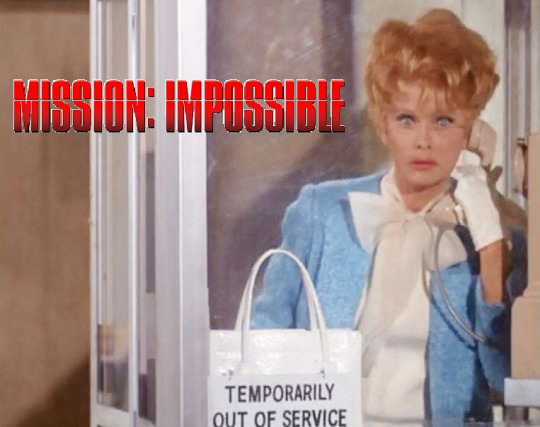
“Lucy’s Impossible Mission” (1968)
Lucy mistakenly enters a phone booth meant for a secret agent and becomes embroiled in a mission impossible. This episode is a spoof of the TV series “Mission: Impossible” (1966-73) which was a Desilu / Paramount series. Had Lucille Ball not given the nod to the series in 1966, there would be no Mission: Impossible movies today!
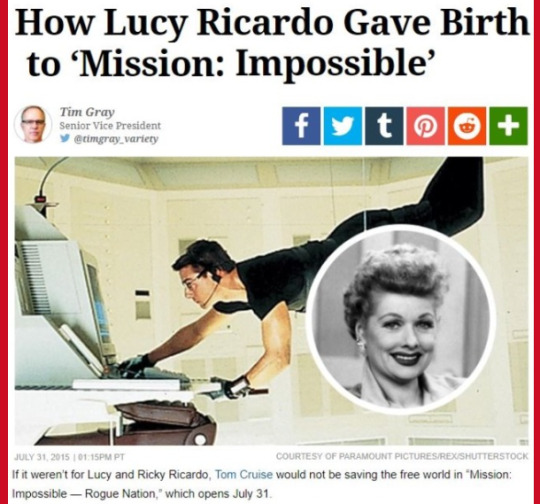
The episode uses the “Mission: Impossible” theme and original underscoring by Lalo Schifrin. The theme won a Grammy Award earlier in 1968. The instantly recognizable theme song is saved for the final chase sequence.

“Lucy and Carol Burnett” (1969)
Lucy convinces Carol Burnett to participate in a benefit to raise money for Kim and Craig’s high school gymnasium.Lucy and the kids attend a taping of “The Carol Burnett Show,” a CBS program that Lucille Ball herself had already appeared on twice as a guest star and would return to twice more. "The Carol Burnett Show” always opened with her taking questions from the studio audience, so this is recreated on “Here’s Lucy”. A new episode of “The Carol Burnett Show” aired at 10pm on the same evening this “Here’s Lucy” was first broadcast.
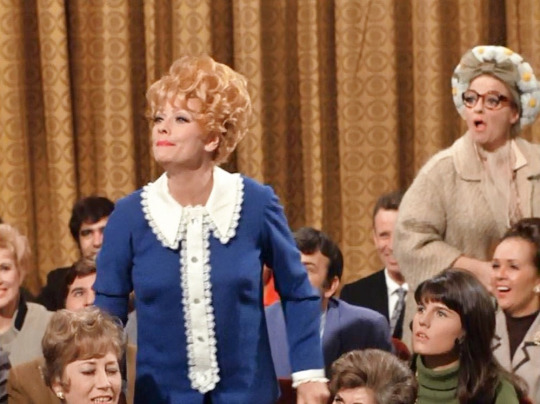
“Here’s Lucy” attempts to physically reproduce “The Carol Burnett Show” studio and stage, even using the CBS eye gold curtain. The audience section, however, is much smaller on “Here’s Lucy.”

“Lucy and Tennessee Ernie’s Fun Farm” (1969)
A farmer (Ernie Ford) wanders into the Unique Employment Agency in need of farmhands. Instead, Lucy proposes they turn his farm into a vacation spot for city folks. They start with a TV variety show and commercial to get the word out!

The commercial that Lucy and Harry do for Ernie’s Fun Farm gives us a glimpse of them as a dysfunctional married couple, complete with two typical teenage kids!

The commercial turns into a fully-staged musical revue.

“Lucy and the Used Car Salesman” (1969)
When the Carters want to become a two-car family, Kim and Craig visit a used car dealer named Cheerful Charlie (Milton Berle).
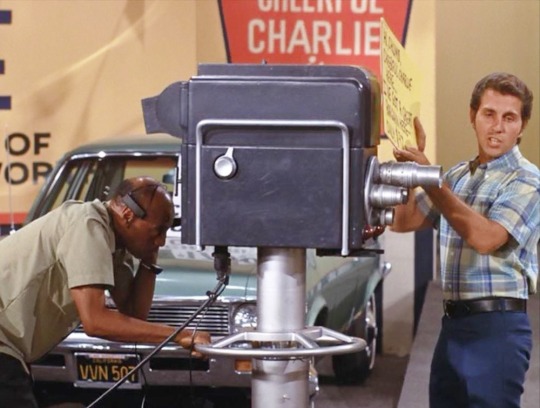
Cheerful Charlie makes his pitch using a television commercial.

In the commercial, Charlie’s chatter is chock full of alliterative chit-chat!

“Lucy and Johnny Carson” (1969)
When Harry takes Lucy and the kids to the filming of an educational TV show, Lucy wangles their way into “The Tonight Show” instead. Playing ‘Stump the Band’, Lucy and Harry win dinner at the Brown Derby.

From 1968 to 1980 Lucille Ball made 16 appearances on “The Tonight Show” with Johnny Carson and Ed McMahon. One appearance was just two weeks before this episode initially aired. “Here’s Lucy” recreates the stage and studio audience of “The Tonight Show”. The iconic multi-colored stage curtain is reproduced and the show’s theme music is used.
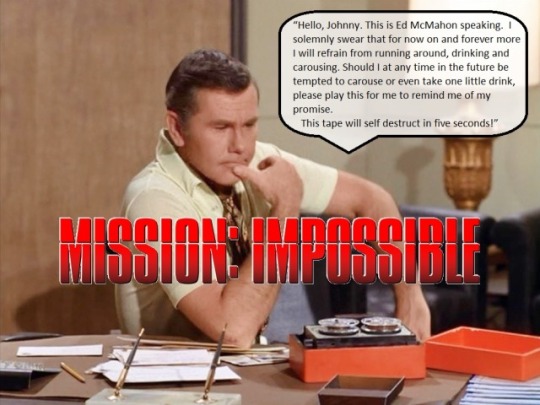
In the office, Ed leaves Johnny a box containing a small tape recorder that leaves a message vowing he will “go on the wagon”. During the playback, the “Mission: Impossible” music plays on the soundtrack. The message concludes with “This tape will self-destruct in five seconds.” This is a spoof of the TV series “Mission: Impossible”(1966-73), which was a Desilu / Paramount series.
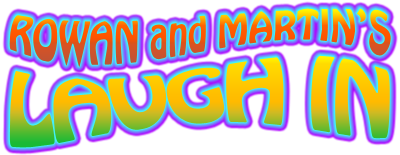
After Craig jokes that Kim should wear three earrings, she quips “Very funny. Which one are you today? Rowan or Martin?” This is yet another of almost bi-weekly references to “Rowan and Martin’s Laugh-In,” “Here’s Lucy's” phenomenally successful competition on ABC.
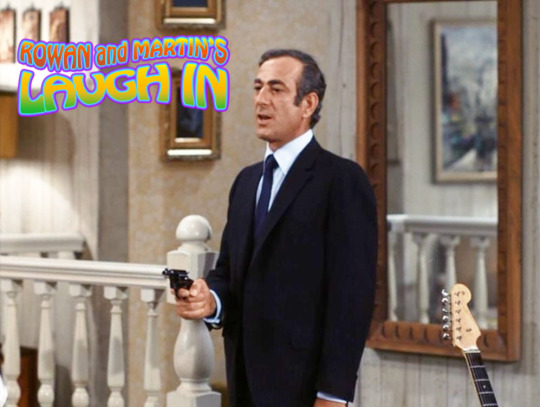
“Lucy’s Burglar Alarm” (1969)
When Lucy surrenders a measly $1.19 to the burglar (Guy Marks), he remarks “For this I had to miss ‘Laugh-In’?”

“Lucy and the Generation Gap” (1969)
Kim and Craig are in charge of producing the school play. In a nod to Desilu’s series “Star Trek” (1966-69), at the opening of the space age segment, Craig (with the help of the Desilu special effects department) materializes in a transporter tube. Beam me up, Lucy!
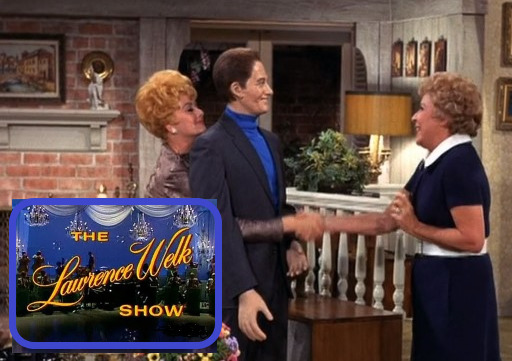
“Lucy and Lawrence Welk” (1970)
VIVIAN (To ‘Lawrence Welk’): “I watch your show every Saturday night!”
When Vivian visits, she expects Lucy to fulfill her promise to arrange a date with Lawrence Welk. Lucy doesn’t know Welk, so she borrows a wax dummy and convinces Vivian to give up her glasses. “The Lawrence Welk Show” began airing in June 1955 and had a remarkable 16 year run on ABC TV before being syndicated for a further 11 years ending in 1982. Welk was as associated with Saturday nights as Lucille Ball was with Mondays. Two days before this episode first aired (January 17, 1970) Welk’s guest was Ted Mack, legendary bandleader and talent scout.

“Lucy and Ann-Margret” (1970)
A chance meeting with Ann-Margret leads to songwriter Craig performing with her on television. On December 6, 1969, Lucille Ball guest-starred on “Ann-Margret: From Hollywood with Love” on CBS. Ball played herself and a character named Celebrity Lu, an autograph hound, opposite Autograph Annie (Ann-Margret).
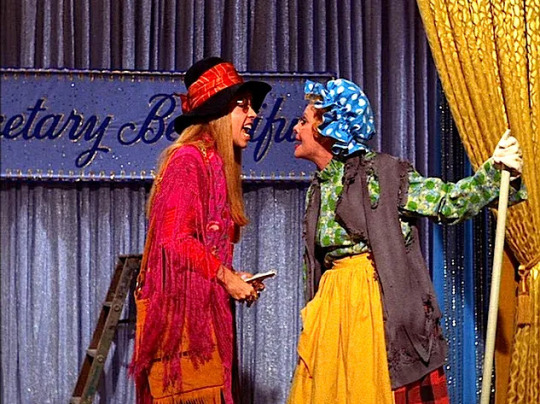
“Lucy Competes with Carol Burnett” (1970)
Lucy dresses like a charwoman identical to the character created by Burnett for her variety series “The Carol Burnett Show”. When Carol Krausmeyer (disguised as a hippie reporter) asks how Lucy Carter thought up such a goofy outfit, Lucy replies “from some goofy dame on TV.” Carol says “Well, she must be some kind of nut!”

“Lucy Loses Her Cool” (1970)
Lucy goes on "The Art Linkletter Show” and is challenged not to lose her temper for 24 hours in order to win $500. Lucy Carmichael also appeared on “The Art Linkletter Show” on “The Lucy Show.” Lucille Ball appeared on “House Party with Art Linkletter” in 1964.
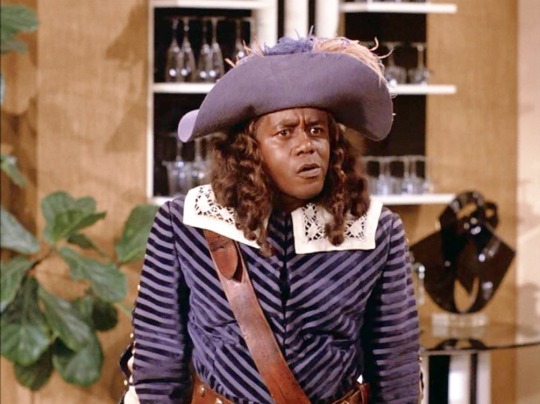
“Lucy and Flip Go Legit” (1970)
Lucy takes a temp assignment with Flip Wilson in order to answer his fan mail. Although it is never explicitly stated, Flip Wilson is preparing for his weekly television variety show “Flip” (1970-74). His most famous creation is Geraldine, a sassy woman with the catch phrase “The devil made me do it” and an unseen boyfriend named Killer. In the episode he is rehearsing a “Three Musketeers” sketch.

“Lucy and Mannix are Held Hostage” (1970)
Lucy happens to see three crimes in one day. Convinced thugs are after Lucy, Harry contacts his old friend, private eye Joe Mannix (Mike Connors). The private detective series “Mannix” from 1967 to 1975, which ran on CBS concurrently with “Here’s Lucy.” “Mannix” was an hour-long crime drama that was saved from the scrap heap by Lucille Ball when she was in charge of Desilu Studios. CBS planned to cancel the show after one season, but Ball used her influence to convince them to renew it with the assurance that changes would be made. In the second season, Joe Mannix was changed into a more hard-boiled independent private detective. The changes worked and the series became a big hit running for eight seasons. It was the last successful TV show to be produced by Desilu.

“Lucy and the Astronauts” (1971)
Harry takes Lucy along to a NASA splash-down, but before the astronauts can be medically cleared, Lucy has kissed them forcing Lucy and Harry to join the space travelers in isolation. Before reporting to an aircraft carrier to watch the splash-down, Lucy watches a moon walk on TV at home. Apollo 15 was launched on July 30, 1971, just a few months before this episode aired. The two-day mission sent astronauts David Scott and James Irwin to the moon.
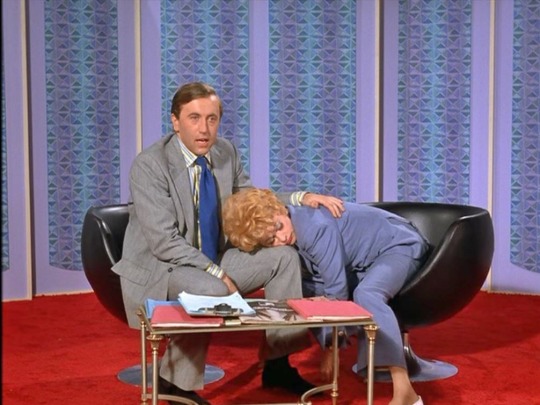
“Lucy Helps David Frost Go Night-Night” (1971)
Television host David Frost hires Lucy as his traveling companion to assure that he gets some sleep on his flight to London. When she gets to London, she is so exhausted she falls asleep on his television show. Frost hosted a US talk show “The David Frost Show” from 1969 to 1972. The evening this episode first aired “The David Frost Show” featured Frost interviewing Lauren Bacall. Starting in 1970, Lucille Ball appeared on “The David Frost Show” five times, with the fifth appearance just two weeks before this episode first aired.
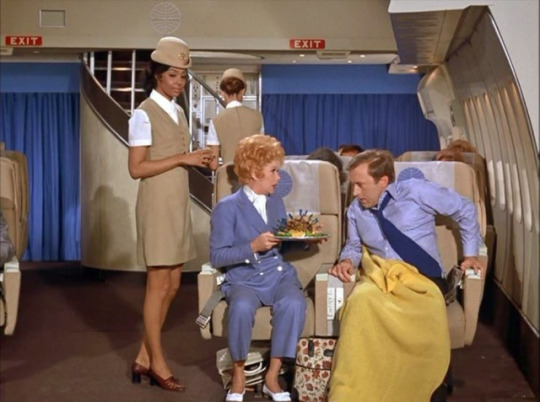
Complimenting David Frost, Lucy mentions that she saw him on “The Carol Burnett Show.” Frost appeared on the variety show in May 1971, six months before this episode first aired.
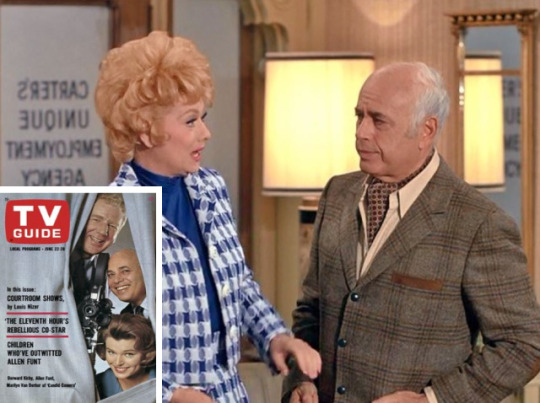
“Lucy and Candid Camera” (1971)
Allen Funt has a criminal impostor who recruits Lucy, Harry and Kim to commit robberies under the pretense that they are doing stunts for his “Candid Camera” television show. “Candid Camera” began on radio as “Candid Microphone” and moved to television in 1948. Although aired on all three major networks and in syndication, the radio program was originally aired on CBS and sponsored by Philip Morris, just like “I Love Lucy.”

“Lucy’s Lucky Day” (1971)
To capitalize on what seems to be a lucky streak, Lucy goes on a TV game show. Dick Dunkirk (Dick Patterson) is the host of “The Milky Way to Riches” sponsored by Dover Dairy. Lucy must answer three geography questions to qualify to earn a chance to win $1,000:
DICK: Where is the lowest point in the world below sea level?
LUCY: Oh, boy. I’m dead, see —
~Answer: The Dead Sea
DICK: The Dead Sea is part of the border between Jordan and what other country?
LUCY: Oh, boy. That question is real tough –
~ Answer: Israel
DICK: It’s an autonomous region of China, bordered by China on the north and east, by India on the south and Cashmere on the West. Name this Chinese autonomous region.
LUCY: And I wanted to bet I’d win.
~Answer: Tibet
After answering three questions, Lucy has to pick between three doors, just like on the TV game show “Let’s Make a Deal.” Lucy picks door #2, which is the gag prize, an untrained chimpanzee named Jackie, which she must teach to do a trick to get the money.

“Lucy and Joe Namath” (1972)
Lucy and Namath watch “The National Football League's Salute to the Quarterback” on her TV. Actual clips of Namath on the field for the New York Jets (#12) are featured.

Namath is delighted, but Lucy cringes at the physical violence. Coincidentally, “Here's Lucy's” main competition during the 1972-73 season was “Monday Night Football” on ABC. The night this episode first aired the Oakland Raiders bested the Houston Oilers 34 to 0.
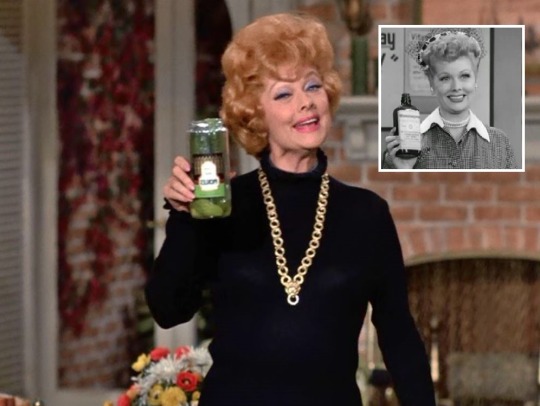
“Lucy is Really in a Pickle” (1973)
LUCY: “Thank goodness I remembered to bring Polly Parker’s Perky Pickles. Mmmm, they’re delicious! Yes, Polly Parker’s Perky Pickles make any picnic perfect. Polly’s Pickles will tickle your pallet. So next time you’re planning a picnic, pick up a pint of Polly Parker’s Perky Pickles.”
Lucy’s show business aspirations get her cast in a pickle commercial. Her alliterative pitch is foiled by the sour taste of the pickles, just like the alcohol in Vitameatavegamin was the undoing of Lucy Ricardo’s television commercial.

The TV camera in the studio is labeled KBEX COLOR. Similar to the way 555 is the prefix used for fictional telephone numbers, KBEX were the call letters for fictional TV and radiostations. They were used in many TV shows and films, including in Desilu’s “Mannix” and “Mission: Impossible.”

When the commercial pitch is suddenly changed to a duet song and dance number, Lucy and Kim become singing and dancing pickles - literally.

“Lucy and Chuck Connors Have a Surprise Slumber Party” (1973)
When Connors is filming a movie in Lucy’s home, Harry mentions that he is also the star of a popular television show. “Thrill Seekers” was a syndicated television series that was produced in 1973 and 1974. Hosted by Connors, it featured people who did dangerous stunts. In Lucy’s kitchen, Connors wears his orange “Thrill Seekers” jacket. The name of the show is stitched on the sleeve. Lucy tells Connors that she has seen “The Rifleman” reruns three or four times. “The Rifleman” was a Western television program starring Chuck Connors as rancher Lucas McCain.The show aired on ABC from 1958 to 1963.
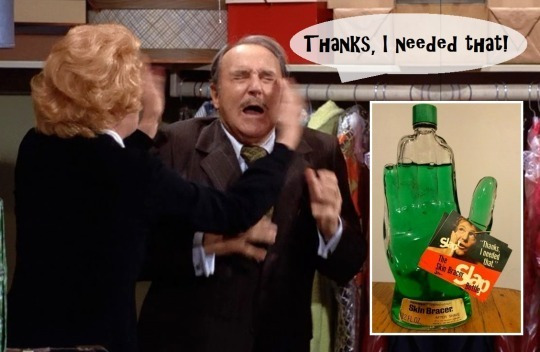
“Lucy Plays Cops and Robbers” (1973)
When Harry panics after being locked in the closet by the burglar, Lucy slaps him and he says “Thanks. I needed that.” This is a reference to a ubiquitous TV commercial for Mennen Skin Bracer Men’s Cologne. The TV ads originally starred John Goodman (“Roseann”).

“Milton Berle is the Life of the Party” (1974)
Milton Berle appears on a TV telethon auction raising money for a Day Care Center Fund. Berle offers his services as a guest at a party thrown by the highest bidder - Lucy!

“Lucy Carter Meets Lucille Ball” (1974)
A televised Lucille Ball look-alike contest is sponsored by Mais Oui Perfume. Lucy and Kim hope to win the grand prize - a sports car. The episode opens with Lucy and Kim rushing home to catch a movie on television.
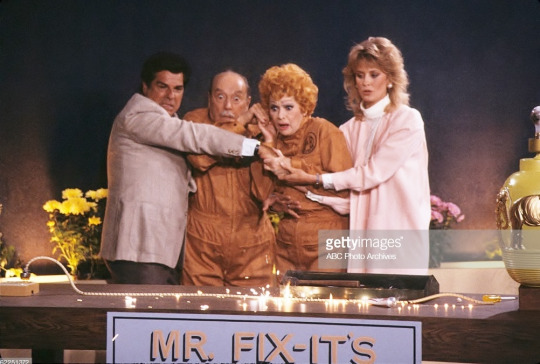
“Lucy Gets Her Wires Crossed” (1986)
With competition from other hardware stores, Lucy gets Curtis booked on a morning TV show as Mr. Fix-It. Lucy goes along as his helper and ends up gluing herself to everyone! “Wake Up Pasadena” is hosted by Fred Dunlap (Dick Gautier) and Stacy Reynolds (D.D. Howard).

LUCY (to Curtis): “Let grandma be on television!”
[Photos of “Life with Lucy” property of Getty Images]
#Television#TV#Lucille Ball#Here's Lucy#Life With Lucy#Gale Gordon#Lucie Arnaz#Desi arnaz Jr.#Jackie Gleason#Carol Burnett#Tennessee Ernie Ford#Johnny Carson#Ann-Margret#Lawrence Welk#David Frost#Flip Wilson#Allen Funt#Joe Namath#Chuck Connors#Mike Connors
7 notes
·
View notes